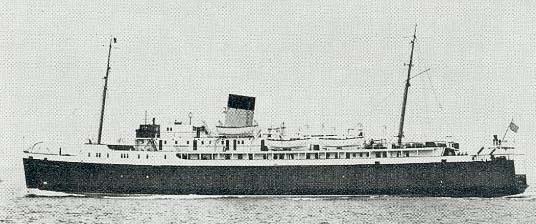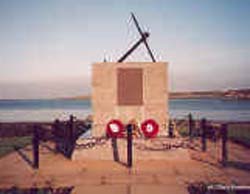|
|
| |
The
31st January 1953 is well remembered in the town of Larne
in County The Princess Victoria was launched in 1947 for British Rail, she was commanded by Captain Ferguson who lived in Stranraer, and most of the crew lived in that town and Larne, she was designed to carry passengers, vehicles and cargoes. After difficulty loading cargo due to the high winds the ship set sail from Stranraer just before 8am on 31st January. On reaching the mouth of Lough Ryan the ship encountered massive seas thrown up by a howling gale. It was at this point that Captain Ferguson set the ship on a northerly coarse, soon after it was decided to return to Stranraer. Shortly thereafter a huge wave struck the bow doors, buckling and forcing them open, when crew visited the car deck they found it awash, soon afterwards a Morse code message was sent "Princess Victoria to Portpatrick Wireless Station - Hove to off mouth of Loch Ryan. Vessel not under command. Urgent assistance of Tug required." For whatever reason The Princess Victoria was only able to communicate in Morse Code while other vessels and the lifeboats were using wireless radios, this fact led to delays in relaying information, crucially the position of the stricken vessel.
The Princess Victoria estimated her position as somewhere off the Scottish coast so it was to this area that the rescue ships headed which was some 10 miles distant from her actual position. At 12 noon the captain ordered life jackets to be distributed and at 13.35 pm the ships crew spotted the lighthouse on Mew Island one of the Copeland group off the Ulster coast by then she was in grave danger listing 45 degrees. The order to abandon ship had been given at 13.30 pm life rafts were launched but many were capsized, their occupants thrown into the sea. Number 4 lifeboat was loaded with women and children the seas dashed the boat against the ships side and all were lost. The last message received from The Princess Victoria arrived at 13.58 pm her radio officer David Broadfoot, who was at his post to the end sent "SOS estimated position now 5 miles east of Copeland's, Entrance Belfast Lough" At around 2.00 pm according to survivors The Princess Victoria rolled over and slid beneath the waves. It was not until 14.40 that the first rescue ship The 'Orchy' arrived on the scene, she reported seeing survivors in the sea and on life rafts, she was joined shortly after by The 'Pass of Drumocter' and the Donaghdee lifeboat The Samuel Kelly, also the Portpatrick lifeboat. The rescued survivors were brought ashore at Donaghdee where The Imperial Hotel had been readied to receive the survivors. With the survivors safely ashore the unenviable task of looking for bodies was begun eventually many were found washed ashore miles from the disaster scene. Immediately following the sinking services of remembrance were held in Donaghadee, Larne and Stranraer. The official enquiry was held in March 1953 at
The Crumlin Road Questions have been asked regarding the tragedy and if it could have been avoided. An incident occurred on 25th October 1949, the ship was on passage from Larne to Stranraer carrying a number of milk tankers, in heavy seas some of the tankers broke loose causing the ship to list. On reaching Stranraer the ship was unable to dock because of the list, it was decided to drain the tankers when this was done it was observed how slowly the milk drained into the sea. This inadequacy manifested itself again in November 1951 when seawater entered the car deck and the scuppers were unable to discharge the water quickly enough. It is hard to understand in the light of the two incidents listed above that modifications, which in all possibility may have resulted in a few days withdrawal from service were not made. A similar incident occurred on 6th March 1987 when the British-owned cross-channel ferry the 'Herald of Free Enterprise' left Zeebrugge, Belgium, with its bow doors open. The ferry capsized killing 193 passengers. Princess Victoria.
See our page on The Titanic. |
||||||||||||||||||||||||||
|
|
|
|

 Antrim
and many other towns in Ireland and the UK, it was on that date that a
deep depression crossed the British Isles. The storm created a tidal surge
with exceptionally high tides which battered coastal defenses in Northern
Ireland and Scotland, claiming 300 lives at sea, the single worst disaster
was that of The Princess Victoria one of the first roll on off ferries
plying the route between Larne and Stranraer in southern Scotland, of
the 172 passengers and crew on board 132 lost their lives.
Antrim
and many other towns in Ireland and the UK, it was on that date that a
deep depression crossed the British Isles. The storm created a tidal surge
with exceptionally high tides which battered coastal defenses in Northern
Ireland and Scotland, claiming 300 lives at sea, the single worst disaster
was that of The Princess Victoria one of the first roll on off ferries
plying the route between Larne and Stranraer in southern Scotland, of
the 172 passengers and crew on board 132 lost their lives. The
North Channel was an area which in normal circumstances carried much maritime
traffic, however 31st January was not a normal day and most of this traffic
was lying at anchor sheltering from the gale, many in Belfast Lough
The
North Channel was an area which in normal circumstances carried much maritime
traffic, however 31st January was not a normal day and most of this traffic
was lying at anchor sheltering from the gale, many in Belfast Lough  Courthouse, Belfast, it lasted 25 days after which a 30,000 word report
was issued. Listing the two main reasons for the loss as the inadequacy
of the bow doors and the inability of the scuppers to return water back
to the sea quickly enough after entering the car deck. This water built
up causing the ship to list to starboard, until eventually causing a capsize.
Courthouse, Belfast, it lasted 25 days after which a 30,000 word report
was issued. Listing the two main reasons for the loss as the inadequacy
of the bow doors and the inability of the scuppers to return water back
to the sea quickly enough after entering the car deck. This water built
up causing the ship to list to starboard, until eventually causing a capsize.